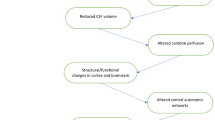Summary
Substance P-like and somatostatin-like immunoreactivities (SPLI and SLI) were determined in ventricular fluid of patients with chronic pain syndromes and in a comparison group with multiple sclerosis, essential tremor, epilepsy and postanoxic myoclonus. Concentrations of SPLI and SLI were non-significantly decreased by 40% and 33% in chronic pain patients as compared with control patients without pain. There were no differences apparent between subgroups of pain patients (deaferentation pain, neoplasia-induced pain, thalamic pain). High pressure liquid chromatography combined with radioimmunoassay showed marked heterogeneity of SPLI and SLI.
Similar content being viewed by others
References
Almay BGL, Johansson F, Knorring L von, Le Grevés P, Terenius L (1988) Substance P in CSF of patients with chronic pain syndromes. Pain 33:3–9
Chrubasik J, Meynadier J, Blond S, Scherpereel P, Ackermann E, Weinstock M, Bonath K, Cramer H, Wünsch E (1984) Somatostatin, a potent analgesic. Lancet II:1208–1209
Cramer H, Kohler J, Oepen G, Schroeter E (1984) Somatostatin-like immunoreactivity in the cerebrospinal fluid of neurological patients. In: Raptis S, Rosenthal J, Gerich JE (eds), 2nd International Symposium on Somatostatin. Attempto, Tübingen, pp 200–203
Cramer H, Schaudt D, Rissler K, Strubel D, Warter JM, Kuntzmann F (1985a) Somatostatin-like immunoreactivity and substance P-like immunoreactivity in the CSF of patients with senile dementia of Alzheimer type, multi-infarct syndrome and communicating hydrocephalus. J Neurol 232:346–351
Cramer H, Wolf A, Rissler K, Weigel K, Ostertag C (1985b) Ventricular somatostatin-like immunoreactivity in patients with basal ganglia disease. J Neurol 232:219–222
Cramer H, Rösler N, Rissler K, Gagnieu MC, Renaud B (1988) Cerebrospinal fluid immunoreactive substance P and somatostatin in neurological patients with periphral and spinal cord disease. Neuropeptides 12:119–124
Cramer H, Rissler K, Rösler N, Strubel D, Schaudt D, Kuntzmann F (1989) Immunoreactive substance P and somatostatin in the cerebrospinal fluid of senile parkinsonian patients. Eur Neurol 29:1–5
Di Giulio AM, Mantegazza P, Dona M, Gorio A (1985) Peripheral nerve lesions cause simultaneous alterations of substance P and enkephalin levels in the spinal cord. Brain Res 342:405–408
Doran AR, Rubinow DR, Wolkowitz OM, Roy A, Breier A, Pickar D (1989) Fluphenazine treatment reduces CSF somatostatin in patients with schizophrenia: correlations with CSF HVA. Biol Psychiatry 25:431–439
Francis PT, Bowen DM, Lowe SL, Neary D, Mann DMA, Snowden JS (1987) Somatostatin content and release measured in cerebral biopsies from demented patients. J Neurol Sci 78:1–16
Jessell TM, Mudge AW, Leeman SE, Yaksh TL (1979) Release of substance P and somatostatin in vivo, from primary afferent terminals in mammalian spinal cord. Proc Soc Neurosci 5:611
Kuraishi Y, Hirota N, Sato Y, Nino Y, Satoh M, Takagi H (1985) Evidence that substance P and somatostatin transmit separate information related to pain in the spinal dorsal horn. Brain Res 325:294–298
Lembeck F, Donnerer J, Colpaert FC (1981) Increase of substance P in primary afferent nerves during chronic pain. Neuropeptides 1:175–180
Madrazo I, Franco-Bourland R, Leon V, Mena I (1987) Analgesic effect of intracerebroventricular (icv) somatostatin-14 (SOM-14), arginine vasopressin (AVP) and oxytocin (OT) in a patient with terminal cancer pain. Pain [Suppl] 4:142
Masaki K (1987) A study of B-endorphin and substance P levels in cerebrospinal fluid on lumbar lesion. Tokushima J Exp Med 34:61–69
Massari VJ, Shults CW, Park CH, Tizabi Y, Moody TW, Chronwall BM, Culver M, Chase TN (1985) Deafferentation causes a loss of presynaptic bombesin receptors and supersensitivity of substance P receptors in the dorsal horn of the cat spinal cord. Brain Res 343:268–274
Menetrey D, Basbaum AI (1987) The distribution of substance P-, enkephalin- and dynorphin-immunoreactive neurons in the medulla of the rat and their contribution to bulbospinal pathways. Neuroscience 23:173–187
Moochhala SM, Sawynok J (1984) Hyperalgesia produced by intrathecal substance P and related peptides. Desensitization and cross desensitization. Br J Pharmacol 82:381–388
Mundinger F (1975) Stereotaktische Operationen am Gehirn, Hippokrates, Stuttgart
Nutt JG, Mroz EA, Leeman SE, Williams AC, Engel WK, Chase TN (1980) Substance P in human cerebrospinal fluid: reductions in peripheral neuropathy and autonomic dysfunction. Neurology 30:1280–1285
Oram JJ, Edwardson J, Millard PH (1981) Investigations of cerebrospinal fluid neuropeptides in idiopathic senile dementia. Gerontology 27:216–223
Otsuka M, Takahashi T (1977) Putative peptide neurotransmitters. Annu Rev Pharmacol Toxicol 17:425–439
Pearson J, Brandeis L, Cuello AC (1982) Depletion of substance P-containing axons in substantia gelatinosa of patients with diminished pain sensitivity. Nature 295:61–63
Pernow B (1983) Substance P. Pharmacol Rev 35:85–141
Randic M, Miletic V (1978) Depressant action of methionin-enkephalin and somatostatin in cat dorsal horn neurones activated by noxious stimuli. Brain Res 152:196–202
Sakurada T, Kuwahara H, Sakurada S, Kisara K (1987) Nociceptive responses induced by intrathecally administered substance P and its fragments in mice. Pain [Suppl] 4:195
Schalling M, Arborelius L, Hökfelt T, Post C (1988) Decrease in gene expression of substance P and thyrotropin releasing hormone (TRH) in rat medulla oblongata following treatment with an antidepressive drug. Acta Physiol Scand 134:455–456
Steardo K, Barone P, Hunnicutt E (1986) Carbamazepin lowering effect on CSF somatostatin-like immunoreactivity in temporal lobe epileptics. Acta Neurol Scand 74:140–144
Urban BJ, France RD, Bissette G, Spielmann FJ, Nemeroff CB (1988) Alterations in cerebrospinal fluid concentrations of somatostatin-like immunoreactivity in chronic pain patients. Pain 33:169–172
Wiesenfeld-Hallin Z (1986) Substance P and somatostatin modulate spinal cord excitability via physiologically different sensory pathways. Brain Res 372:172–175
Author information
Authors and Affiliations
Rights and permissions
About this article
Cite this article
Jost, S., Reuner, C., Geiger, J. et al. Substance P-like immunoreactivity and somatostatin-like immunoreactivity in the ventricular fluid of patients with chronic pain syndromes. Eur Arch Psychiatry Clin Nuerosci 241, 109–112 (1991). https://doi.org/10.1007/BF02191152
Received:
Issue Date:
DOI: https://doi.org/10.1007/BF02191152




